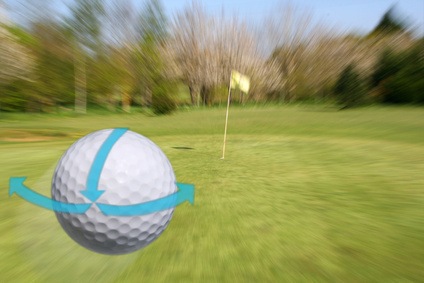
The same force that causes a baseball pitch to curve is responsible for golf shots that turn left or right: sidespin.
Just as it sounds, sidespin occurs when there's a degree of sideways or horizontal rotation (in addition to backspin, or vertical rotation) on the ball. The more sidespin, the more curvature. A small amount of left-to-right spin, for example, results in a fade. Lots of rightward spin causes the more violent slice.
Understanding what causes sidespin is important for two reasons: 1) To diagnose your swing during a bout of slicing or hooked shots; and 2) To learn how to play curving shots intentionally.
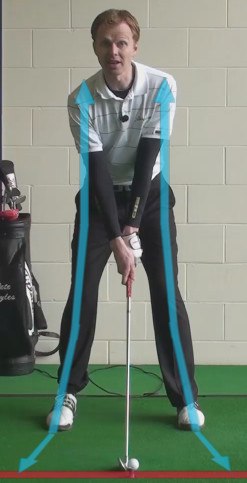 Basically, when the clubface meets the ball at an angle (open or closed) to the club's approach path, sidespin is imparted. Let's examine the slice:
Basically, when the clubface meets the ball at an angle (open or closed) to the club's approach path, sidespin is imparted. Let's examine the slice:
- The golfer is aimed down the middle of the fairway, his feet, hips and shoulders square to the target line.
- During the downswing, the clubhead veers outside the target line as it approaches the ball.
- At impact, the clubface is pointed directly at the target. But because the club's path is cutting across the ball, the face is, in effect, open to this path.
- The combination of path and clubface angle creates left-to-right sidespin. The ball launches in line with the clubhead path, left of target, then curves sharply right.
The opposite occurs on left-curving shots, where the club's path is right of target in relation to the face angle.
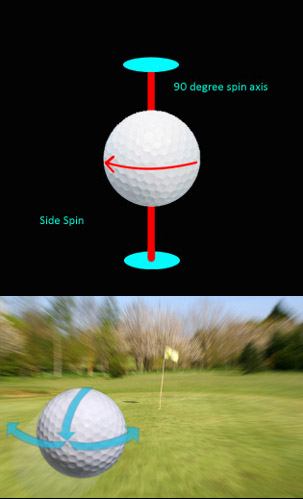
What is Sidespin on the Golf Ball?
Every golf shot that you hit, except for your putts, has spin. Well, even putts technically have spin, but it is minimal and is wiped away as soon at the ball starts to roll along the ground. Although it is misunderstood and undervalued by the average golfer, spin is actually what makes golf such a challenging game. If you can learn to control your spin – which is no easy feat – you will be able to hit consistently good shots, and you will shoot good scores on a regular basis.
As you already know, controlling spin is a job that is far easier said than done. To control your spin properly, you have to move the club through the hitting area with extreme precision. Even a slight miscalculation in the way the club moves through the ball will lead to unintended spin, and the ball will inevitably travel off line. Professional golfers are able to shoot such good scores in large part because they have learned how to control the spin on their golf ball. While you might not ever reach that level of control, even a basic understanding of how to spin the ball both right and left will serve you well going forward.
The idea of hitting a full swing golf shot with no sidespin is essentially a myth. While it is technically possible to strike the ball so perfectly that it only has backspin and no sidespin, that is not a result that you should be counting on. In reality, even great golf shots have a degree of sidespin, so the goal isn't so much to eliminate that spin as it is to learn how to use it to your advantage. If you can harness the sidespin on your golf ball in a way that allows you to get closer to the hole, you will become a better overall player.
It is important to know how to control sidespin with all of your clubs, but it is especially crucial when you are hitting shots from the tee. If you are hitting a driver or even one of your fairway woods, you will need to know how to manage spin in order to get the ball into the short grass – or at least to keep it somewhere in play. Many amateur golfers waste several strokes per round on poor drives, meaning they have to perform nearly perfectly around the rest of the course in order to shoot a good score. By eliminating the big misses off of the tee, you can save those penalty shots and provide yourself with more margin for error during the rest of the round. Not only will reducing sidespin off the tee allow you to shoot better scores, it will simply make the game more enjoyable from round to round. It is hard to have fun when you are worried about hitting wild drives off the tee, so take the time on the practice range to learn how to straighten out your tee shots.
All of the instruction below is based on a right handed golfer. If you happen to play left handed, please take a moment to reverse the directions as necessary.
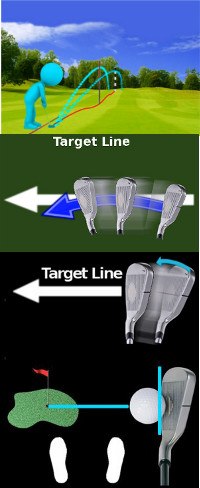
The Origins of Sidespin
To reduce your sidespin successfully, you first have to know where that sidespin is coming from in the first place. Many golfers have a poor understanding of the physics of the game, which makes it very difficult to properly diagnose and correct swing problems. With a clear picture in your mind of what it is that needs to change in your swing, you can come to the proper solutions much faster.
In order to understand sidespin, you need to have a clear understanding of two key ingredients - swing path and club face angle. These are the two elements that will determine how much sidespin is on your ball, and which direction that spin is moving. There are other important things to understand if you want to hit good shots, but when it comes to sidespin, it's all about club face angle and swing path. Following is a quick description of each of these two pieces of the golf swing puzzle.
- Club face angle. At impact, the angle of the club face is obviously important because it will determine the direction that the ball is going to travel initially. A 'square' club face is one that is lined up with your intended target line. An open face is one that is pointed to the right of the target, while a closed face is one that is aimed left at impact. The ability to control the club face through the hitting area is one of the major keys when it comes to becoming a good ball striker. The difficulty of squaring up the club face is increased as your swing picks up speed, meaning it is much harder to square up your driver at impact than it is a pitching wedge or sand wedge.
- Swing path. This is the direction that the club head is moving through the hitting area. Before you start your swing, you should have selected a target line for the shot. Assuming you are trying to hit the ball relatively straight, it is then your job to swing the club down that target line that you have selected. That is a task which is easier said than done. Your swing mechanics and your tempo will have to work together properly in order to move the club along the target line through impact effectively.
If you manage to swing perfectly down the target line with a square club face, you will hit a shot without sidespin. Of course, as mentioned above, that is a rare occasion at best. Instead, it should be your goal to simply minimize sidespin so that you can create ball flights which will help you make your way around the course. Don't spend too much time thinking about being perfect through the hitting area, because perfection is not something that exists in the game of golf.
So now that you know that a perfectly straight shot is usually not going to happen, how do you know which way to expect the ball to turn in the air? The key is understanding the physics that takes place between the ball and the club at impact. When the club contacts the ball, the ball actually 'sticks' on the face of the club for a fraction of a second before it launches off into the distance. During the time that it is in contact with the face, the ball will take on sidespin depending on the direction that the club is moving compared to the angle of the face. Once the ball lets go of the club face and takes flight, the sidespin that it has taken on will determine how it curves through the air.
It is actually very easy to understand what it is that makes the ball curve right or left. When your club face is closed (pointing to the left) relative to the swing path at impact, the ball will turn to the left in the air. In the same way, the ball will turn to the right when the club face is open relative to the swing path when you make contact. The best way to remember how the ball will curve is simply to tell yourself that the ball will curve in the same direction that the club face is pointing. If the face is pointing right compared to the swing path, the ball is headed right. Face pointing left relative to your path? Expect to look up and see your ball curving to the left.
To think about this concept in terms of an example that most golfers can relate to, you have to look no further than the slice. Countless golfers struggle with a slice, which is simply a term to refer to a shot that curves sharply from left to right for a right handed golfer. When you see the ball curving dramatically from left to right, you should instantly know that the face was wide open relative to the swing path. Most likely, the golfer both left the face open and swung across the ball from outside to in - basically meaning that both the path and the face angle were contributing to the slice. If you are one of the golfers who does struggle with a slice, you will need to correct each of these two elements if you want to straighten out your ball flight once and for all.
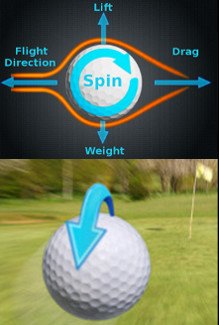
The Role of the Ball
Do you know what you are looking for when you pick out a golf ball at your local pro shop, or do you simply buy a dozen because they are on sale? If you are strictly a sale shopper, you might be missing out on the opportunity to improve your game by purchasing a ball that is well-suited to your skills. Not all golf balls are created equal, and finding the right ball for your game could go a long way toward making you the best player you can be.
Depending on the materials used in the golf ball you purchase, and the design of that ball, you will get a specific spin rate that will not necessarily be the same as what is offered by other balls on the market. Premium golf balls tend to spin more than discount models, which means that an expensive golf ball should be expected to provide you with more backspin and more sidespin. Many golfers make the mistake of forgetting about the sidespin part of the equation when they shop for a ball. They get excited about the prospect of a premium ball enabling them to achieve a high rate of backspin, but forget that that backspin rate will also come along with plenty of sidespin.
Only players who are capable of controlling that sidespin correctly should opt for a premium ball. For everyone else, it is actually best to use a less-expensive ball which offers a lower spin rate. Less spin will mean that you don't have to be as perfect through the hitting area in order to hit good shots, so you can relax and simply do your best to reach a square position. Using a high spin ball without the necessary skills to control that ball will make the game harder than it needs to be - and the game is plenty difficult to begin with. If you don't feel like you have the necessary control over your swing to manage a high spin ball, save yourself some money and purchase a discount model that provides lower spin and increased forgiveness.
Picking the right golf ball is a balance between performance on full swings and performance around the greens. While a lower spin ball will help the average golfer on full shots thanks to less side spin, the reduced backspin around the greens can make it tough to get up and down. There might not be a 'perfect' golf ball on the market that will give you all of the characteristics you are looking for, so the best idea is to shop around and try out a few different models. You will likely need to make a small sacrifice in one area of your game or another, so be realistic with your expectations and pick the ball that balances all factors most effectively.
Remember when shopping for a golf ball that you aren't necessarily making a decision that will have to last you for years. A dozen golf balls is only a $30 or $40 investment on the high end of the market, so you aren't committed to that brand of balls like you might be a new driver that you decide to purchase. A driver could run you somewhere in the range of $300 to $400, meaning you are going to want to get a lot of use out of that particular club. A box of balls isn't nearly the same kind of financial commitment, so you can always test out a new model after your current dozen has run out.

Dealing with the Wind
As if there weren't already enough variables to deal with on the golf course, your brain will have to process yet another challenge when the wind decides to come up. Playing golf on a windy day is a particular challenge because you will have to change much of what you normally do during calm conditions. For example, if you usually hit the ball high in the air with your short irons, you may have to alter your approach in order to bring your flight down and keep the ball out of the breezes. That means changing your swing technique on the fly, which is something that many amateur golfers simply aren't prepared to do.
Wind has a particularly nasty effect on shots with a high rate of sidespin. If you are playing into the wind either off the tee or from the fairway, that breeze will further the effects of the sidespin that you put on the ball. So, for instance, if you hit a shot which would normally be a nice little draw on a calm day, that ball may quickly hook to the left and find its way into trouble. The same is true for a ball that is turning to the right – a gentle fade can easily be turned into a wild slice by a gusty wind. As any experienced golfer will tell you, on a windy day, pure ball striking is absolutely at a premium.
So how can you make sure that your ball striking is at its best when the wind is threatening to turn your decent shots into poor ones? The main step you should take is swinging softer. There are two specific benefits to making softer swings in the wind. First, your soft swing will enable you to remain well-balanced during the swing itself, which will generally lead to better ball striking. You have to hit the ball clean to have any chance in the wind, and it is tough to hit clean shots when swinging as hard as you can.
The other advantage to swinging softer is the reduced spin rate that you will impart on the golf ball. Softer swings lead to less spin – both backspin and sidespin – than do hard swings. Therefore, a soft swing has a much better chance to carve through the wind cleanly than does a shot which was struck aggressively. As a good rule of thumb, take extra club when playing in windy conditions and make soft swings which allow the ball to fly close to the ground.
The reality of the game is that you are never going to be able to play as well in the wind as you will in calm conditions. You may be able to occasionally post a great score while the wind is blowing, but anything more than a breeze will usually cost you a shot or two during the course of the round. However, that doesn't mean that you still can't have fun playing the game in the wind while working hard to produce good shots. To avoid having your shots get carried away by the wind, dedicate yourself to swinging softer throughout the day and you will enjoy the level of control you have over the ball.

Practicing Your Curves
The bad part of sidespin is that it can send your ball turning in all sorts of bad directions, leaving you in the water, trees, sand, or other undesirable places. On the positive side, however, you can use sidespin to carve your ball around obstacles in order to get close to the target. An accomplished player will be able to turn the ball both left and right on demand based on the hole that they are playing. If you can get your game to point where you can use sidespin to your advantage, you will be well on your way to some great scores.
So, when you are ready to practice curving the ball, should you head to the driving range? Well, maybe not. The problem with practicing your curves on the driving range is that driving range balls offer an extremely low spin rate compared to 'regular' golf balls. Therefore, if you learn how to hit a little draw on the range, that little draw will probably turn into a hook on the course. Unfortunately, the only real way to dial in your ability to curve the ball is to work on it on the course with your actual golf balls.
That isn't to say that the driving range is totally worthless, however. You can learn the basics of how to alter your club face position and swing path on the range, but you will need to master those skills out on the golf course. Practice making some basic adjustments on the range to turn your draw into a fade, and vice versa. Once you understand how to carve the ball on command with relative consistency, start hitting some of these on-demand shots on the course. At first, you probably won't have great control over your shaped shots, but stick with it until you learn how to make subtle adjustments rather than dramatic ones. You don't want to have to hit too many carved shots during the course of an average round, but it is nice to have the ability to call on this kind of shot when necessary.
Most golfers don't truly understand sidespin, and therefore the game remains somewhat of a mystery to them. Now that you have the basic knowledge necessary to understand why the ball turns to the left or right, you can get back to work on improving your ability to control your sidespin – and control your shots in general. With the right ball and the right swing technique, it is possible to use sidespin to your great advantage on the course.






